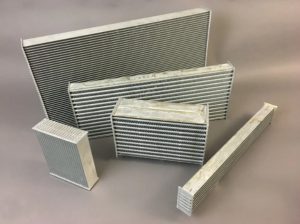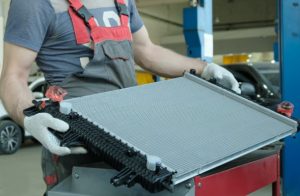The radiator is the heart of your vehicle’s cooling system. Its primary job is to transfer heat from the engine coolant to the outside air, ensuring the engine maintains an optimal operating temperature. While many drivers focus on the size, shape, or brand of a radiator, one of the most critical factors influencing its performance is the core material. The materials used in radiator cores directly affect heat transfer efficiency, weight, durability, corrosion resistance, and overall longevity.
In this guide, we’ll dive into the most common radiator core materials, how they differ, and how these differences impact cooling performance — helping you make a smarter decision when upgrading or replacing your radiator.
What Is a Radiator Core?

The radiator core is the central part of the radiator where heat exchange occurs. It consists of a network of tubes and fins through which coolant flows and air passes. As the coolant circulates, it releases heat into the fins, and airflow removes this heat from the vehicle.
The choice of material for these tubes and fins is essential because it affects how quickly and effectively the radiator can transfer heat.
Common Radiator Core Materials and Their Properties
Here’s a comparison of the most widely used materials in automotive radiators:
| Material | Heat Conductivity | Weight | Corrosion Resistance | Cost | Durability |
|---|---|---|---|---|---|
| Copper | ★★★★★ (Excellent) | Heavy | ★★★☆☆ (Moderate) | $$$ | ★★★★☆ (Good) |
| Brass | ★★★★☆ (Very Good) | Heavy | ★★★★☆ (Good) | $$$ | ★★★★☆ (Good) |
| Aluminum | ★★★★☆ (Very Good) | Light | ★★★★★ (Excellent) | $$ | ★★★★☆ (Good) |
| Plastic-Alu Hybrid | ★★★☆☆ (Average) | Very Light | ★★★★☆ (Good) | $ | ★★☆☆☆ (Fair) |
Detailed Look at Each Material
1. Copper: Superior Heat Transfer, Classic Choice
Copper has long been the gold standard in radiator manufacturing due to its exceptional thermal conductivity. It can transfer heat faster than any other commonly used material, which means more efficient cooling.
Pros:
-
Excellent heat dissipation.
-
Long-lasting and repairable.
-
Great for heavy-duty or high-performance vehicles.
Cons:
-
Heavier than aluminum.
-
More expensive.
-
Prone to corrosion if not properly maintained.
Best for: Classic cars, performance builds, or vehicles that frequently tow heavy loads.
2. Brass: A Durable Partner for Copper Cores
Brass is often used for the tanks and headers in copper-core radiators because of its strength and resistance to cracking. While not quite as thermally conductive as copper, it still performs very well and offers excellent durability.
Pros:
-
Strong and long-lasting.
-
Resistant to pressure and cracking.
-
Often used in combination with copper for maximum performance.
Cons:
-
Heavy and expensive.
-
Slightly lower heat transfer than copper.
Best for: Heavy-duty trucks, industrial vehicles, and older vehicles designed with copper-brass radiators.
3. Aluminum: Lightweight and Efficient
Aluminum has become the modern standard for most passenger cars and performance vehicles. It provides an excellent balance of thermal efficiency, weight savings, and corrosion resistance. Although its heat conductivity is slightly lower than copper, aluminum radiators often compensate with larger surface areas and more efficient designs.
Pros:
-
Lightweight (improves fuel efficiency).
-
Great heat dissipation with proper design.
-
Highly corrosion-resistant.
-
More affordable than copper or brass.
Cons:
-
Difficult to repair if damaged.
-
Not as thermally conductive as copper.
Best for: Daily drivers, performance cars, and vehicles where weight reduction is key.
4. Plastic-Aluminum Hybrids: Budget-Friendly and Practical
Modern OEM radiators often combine plastic tanks with aluminum cores. While this reduces cost and weight, it can compromise durability, especially in extreme conditions. The plastic components can become brittle over time, leading to leaks.
Pros:
-
Lightweight and cost-effective.
-
Sufficient performance for everyday driving.
-
Resistant to corrosion.
Cons:
-
Limited lifespan.
-
Not ideal for high-performance or heavy-duty use.
Best for: Standard passenger vehicles and budget replacements.
How Material Affects Cooling Efficiency
| Feature | Copper/Brass Radiators | Aluminum Radiators | Plastic-Aluminum Radiators |
|---|---|---|---|
| Cooling Efficiency | ★★★★★ (Highest) | ★★★★☆ (High) | ★★★☆☆ (Moderate) |
| Weight Impact | Heavy (Reduced performance) | Light (Improved efficiency) | Very Light (Fuel-efficient) |
| Durability | High (repairable) | High (but hard to repair) | Moderate (shorter lifespan) |
| Corrosion Resistance | Moderate | Excellent | Good |
| Cost | $$$ (Expensive) | $$ (Moderate) | $ (Affordable) |
Factors to Consider When Choosing a Radiator Material
Before selecting a radiator, consider the following factors to ensure optimal performance for your vehicle:
-
Vehicle Type: Heavy-duty vehicles benefit from copper/brass, while lightweight cars often perform better with aluminum.
-
Performance Needs: For racing or high-performance builds, prioritize heat dissipation over cost.
-
Budget: OEM-style plastic-aluminum radiators are the most cost-effective choice but may require earlier replacement.
-
Maintenance Expectations: Copper/brass radiators can be repaired, while aluminum and hybrid designs usually require full replacement when damaged.
Tips to Extend Your Radiator’s Lifespan

-
Use the correct coolant: Incompatible fluids can cause corrosion.
-
Flush the system regularly: Prevent debris and deposits that reduce efficiency.
-
Check for leaks: Early detection can prevent costly engine damage.
-
Keep fins clean: Dirt and debris block airflow, reducing cooling capacity.
Final Thoughts
The choice of radiator core material has a direct impact on your vehicle’s cooling performance, weight, fuel efficiency, and long-term reliability. While copper and brass deliver unmatched heat transfer and durability, aluminum offers a lighter, cost-effective solution with excellent overall performance. Plastic-aluminum hybrids are ideal for budget-conscious drivers but come with shorter lifespans.
When upgrading or replacing your radiator, consider your driving style, performance needs, and budget to find the best solution for your vehicle’s cooling system.
If you’re ready to upgrade, explore high-quality options and Buy Radiator & Components online to keep your engine running cool and efficient for years to come.